
Thematic investing is a forward-looking investment approach that seeks to capitalise on megatrends.
Thematic investing can focus on short-term, more cyclical themes or can focus on structural, long-term themes.
We believe playing thematics potentially creates another opportunity for outperformance. The key benefits of long-term thematics are:
- Significant growth associated with a structural theme.
- Entry timing is also less important as growth should be less dependent on the business cycle over the medium-term (although some thematic stocks may be more cyclical than others)
- Spreads portfolio risk as these returns tend to be less correlated to the general volatility of the market.
- Investors can tailor their portfolio to match their philosophy or values by tilting their portfolio towards a particular theme.
In the Focus Portfolio, we are exposed to a few thematics at present, such as New Infrastructure (NXT, CWY, TLS), Global Reopening (QAN, TAH, ALL) and the Energy Transition (AKE, OZL, STO/WDS).
The Energy Transition
Getting to net-zero over the next 3 decades requires approximately US$130 trillion in clean energy investment from now until 2050, according to the International Renewable Energy Agency.
The transition involves more energy storage and a higher uptake of electric vehicles, both of which will create a higher demand for batteries, specifically lithium-ion batteries.
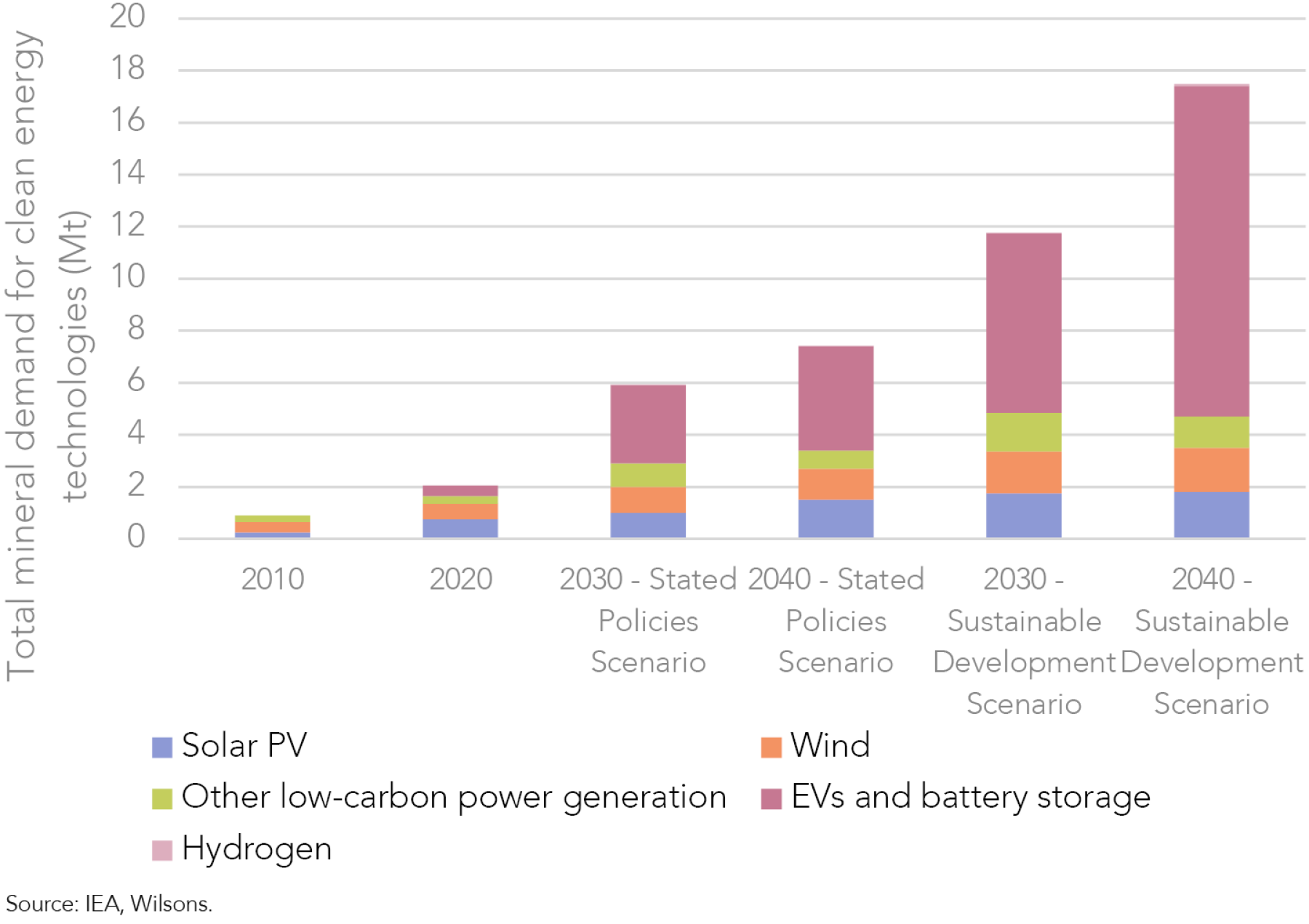
We believe one of the best ways to play this thematic is through the minerals and metals that will be in high demand as we progress through this decade and beyond. The Focus Portfolio has exposure to lithium and copper. However, a whole host of other minerals and metals will be needed for the transition.
We believe the market has not fully quantified the volume of required commodities accurately in relation to the transition, and many battery mineral miners are still undervalued relative to potential growth of their underlying commodities.
Lithium on the Charge
With a significant increase in demand for EV’s comes a significant increase in demand for lithium-ion batteries. We expect demand for lithium to grow by 6-8x between now and 2030.
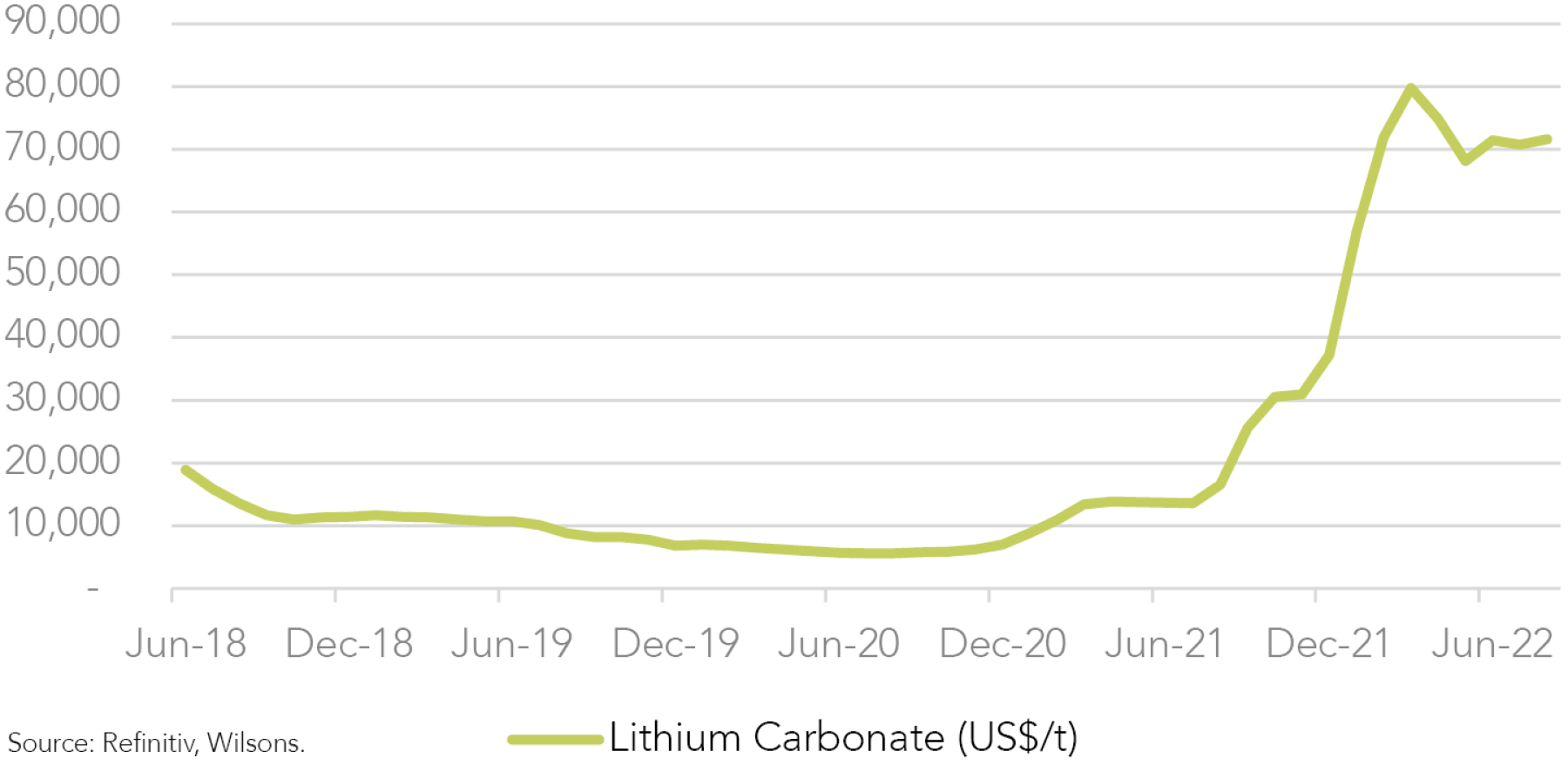
We don’t believe lithium supply can keep up with this level of demand growth. Lead times for lithium mines (from discovery to production) can take 5+ years, so there is no quick fix. If demand can grow at the market’s expected pace, this could lead to large supply deficits from 2025 onwards.
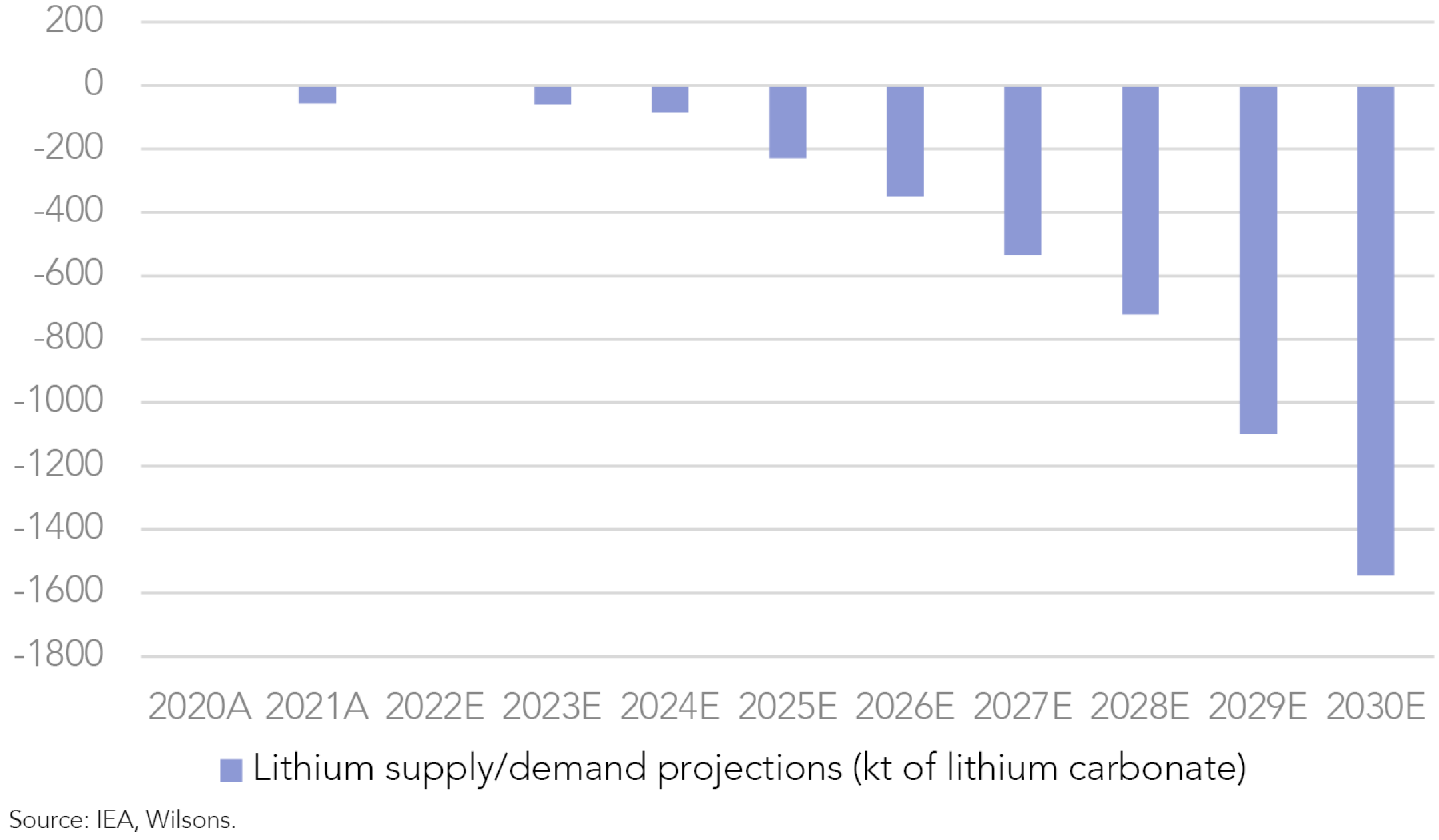
While we expect the price of lithium to fade over time, the forecast price profile seems inconsistent with the forecast supply/demand balance. We believe there could be significant upside to the forecast long-term price if there is a supply/demand imbalance and the current price profile (in Figure 4) looks too pessimistic.
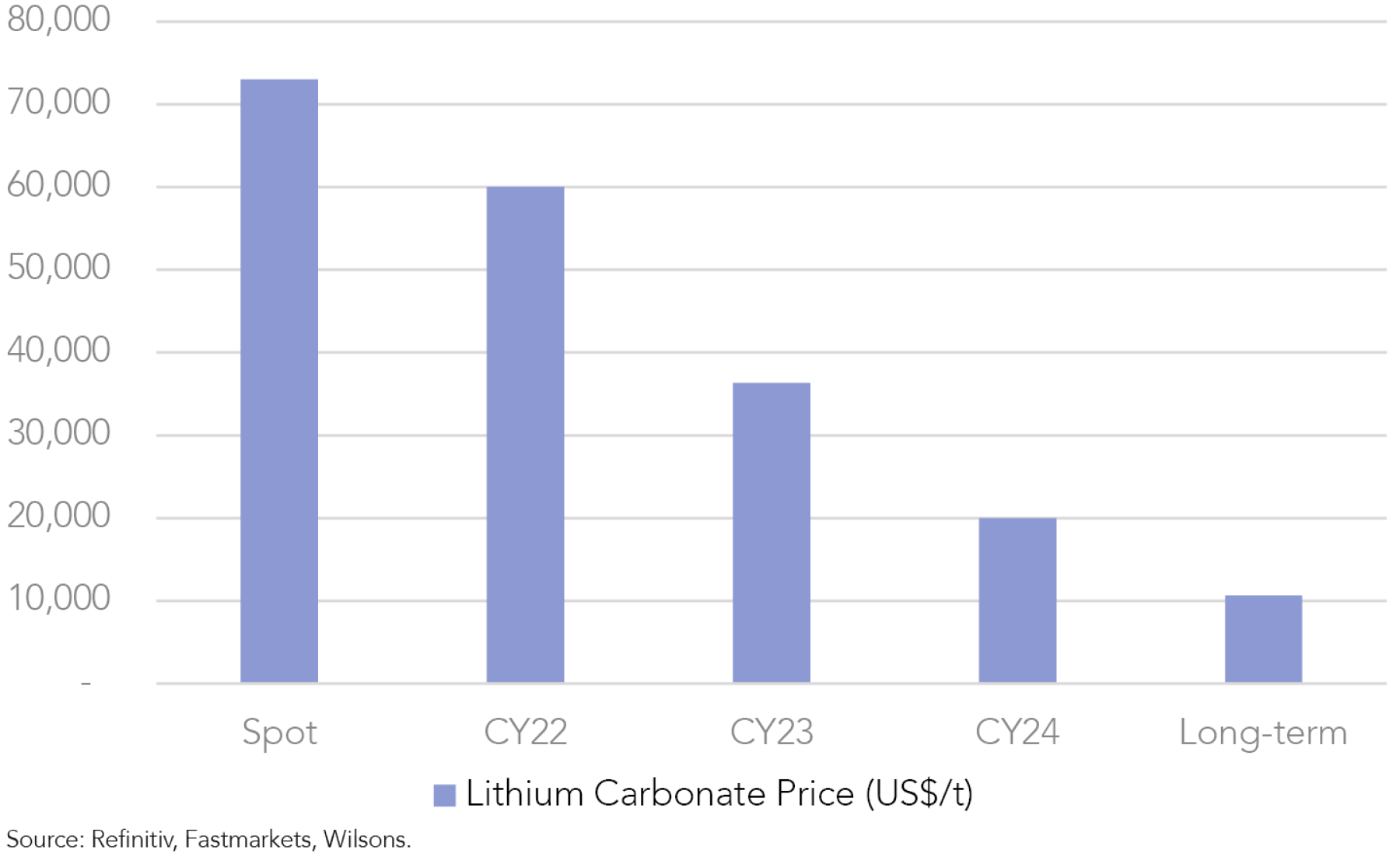
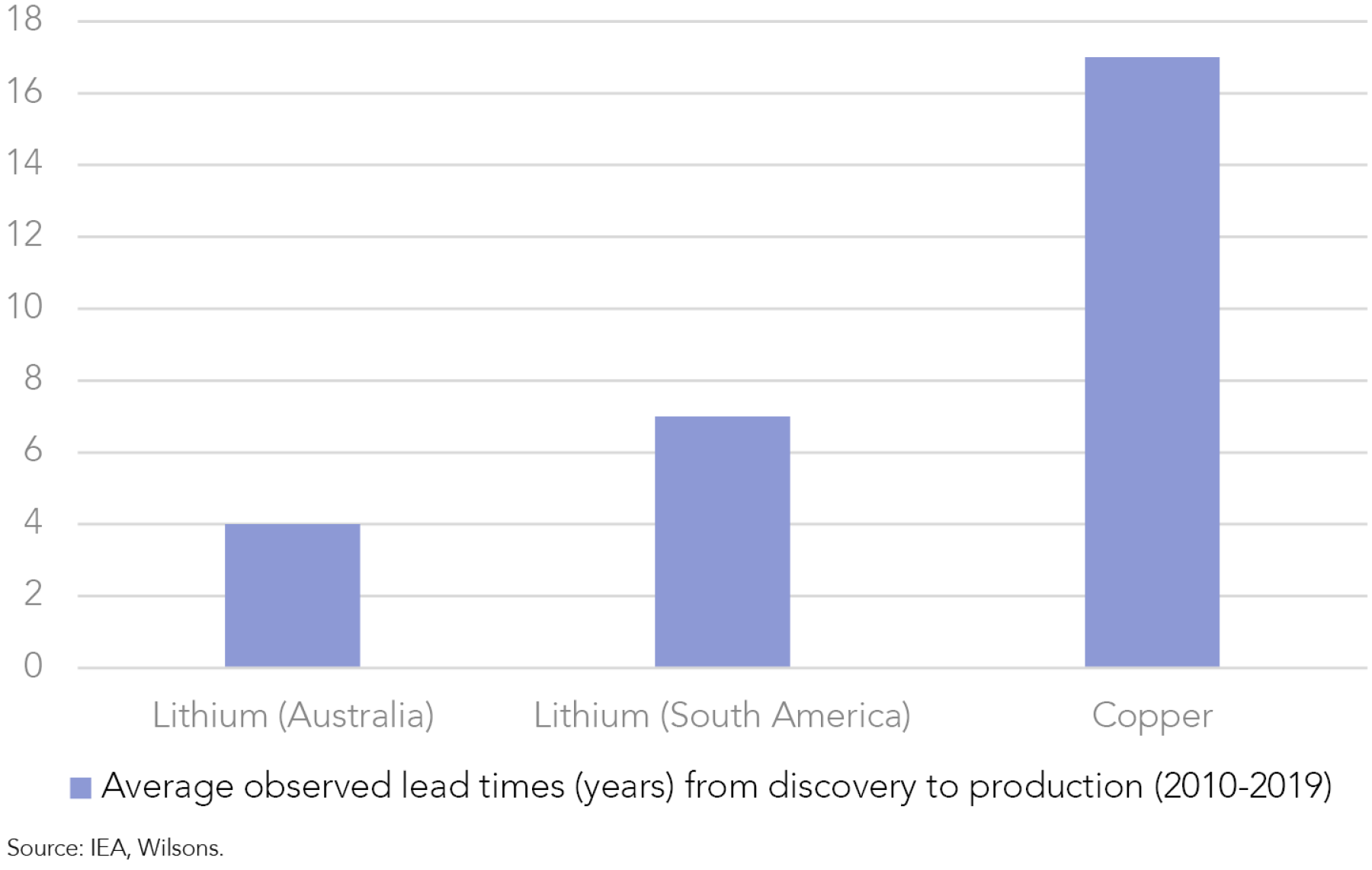
What about other types of battery technology?
When looking at the mineral mix in batteries, all roads still lead to lithium as the core base of battery technology over the next decade. We do not see an alternative to the lithium-ion battery (and hence lithium) in decarbonising the global auto fleet.
There is more uncertainty for graphite, nickel and cobalt in relation to the battery mix; all could be used with lithium as standalone options for battery technologies.
Allkem (AKE) Our Preferred Lithium Exposure
The Focus Portfolio has exposure to lithium through pure-play Allkem (AKE) (3% position).
AKE remains our preferred lithium exposure given:
- AKE is one of the world's top 5 lithium producers, with operations in brine, spodumene, and hydroxide.
- Business operations are spread across Argentina, Australia, Canada and Japan.
- The company has deep brine and hard rock lithium resources and a depth of experience in these fields.
- AKE brine production is low cost relative to the Western Australia spodumene (hard rock) mines.
- We believe consolidation is likely in the pipeline for AKE, one of the biggest players in South America's ‘Lithium Triangle’. The company could acquire smaller explorers to increase its capacity.
Are lithium miners still reasonably priced?
We think so. The AKE share price has gone up ~27% since we increased our weighting to 3% on the 10th August. However, we still think there is value in this name at the current price ($15.34 – 19/09/2022 close price).
While we do not expect lithium prices to remain elevated at these levels over the next 12 months, we believe they will be significantly higher than consensus, which is currently pricing at ~US$36,000/t (vs. spot of US$73,500/t).
If this is the case, there should still be significant upside to AKE’s earnings, leading to analyst upgrades.
Longer term, if the supply deficit is to be believed, we think consensus long-term lithium prices are far too low, and this is also a bullish scenario for AKE’s earnings and cash flow.
We prefer lithium miners, like AKE, who are currently producing lithium. We are more sceptical about the small-cap non-producers. We believe there is more exuberance in the non-producers, and valuations may have overshot fair value.
| Company Name (Ticker) | FY23 EV/EBITDA (Consensus) | FY24 EV/EBITDA (Consensus) | FY25 EV/EBITDA (Consensus) | FY23 EV/EBITDA (Spot) | FY24 EV/EBITDA (Spot) | FY25 EV/EBITDA (Spot) | FY23 EV Upside at Spot | FY24 EV Upside at Spot | FY25 EV Upside at Spot |
| Allkem (AKE) | 5.4x | 5.3x | 5.0x | 4.3x | 2.4x | 1.3x | 26% | 126% | 273% |
| Pilbara (PLS) | 5.2x | 6.3x | 7.7x | 4.2x | 3.2x | 2.0x | 24% | 99% | 283% |
Note: EV upside is calculated using consensus EV/EBITDA multiple and forecast spot EBITDA.
Source: Refinitiv, Wilsons.
Copper – A Critical Input for a Greener Economy
Copper is a popular base metal that is favoured for its electrical conductivity and its low reactivity. The metal is widely used in building construction, infrastructure, electronics and wiring, transportation equipment, consumer products and machinery.
While demand for copper is cyclical in nature, given its wide range of industrial uses, decarbonisation is set to underpin structural growth in demand for the metal. Large quantities of copper will be needed to modernise electrical grids and energy infrastructure, build new solar and wind energy generation capacity and manufacture a growing fleet of electric vehicles (EVs).
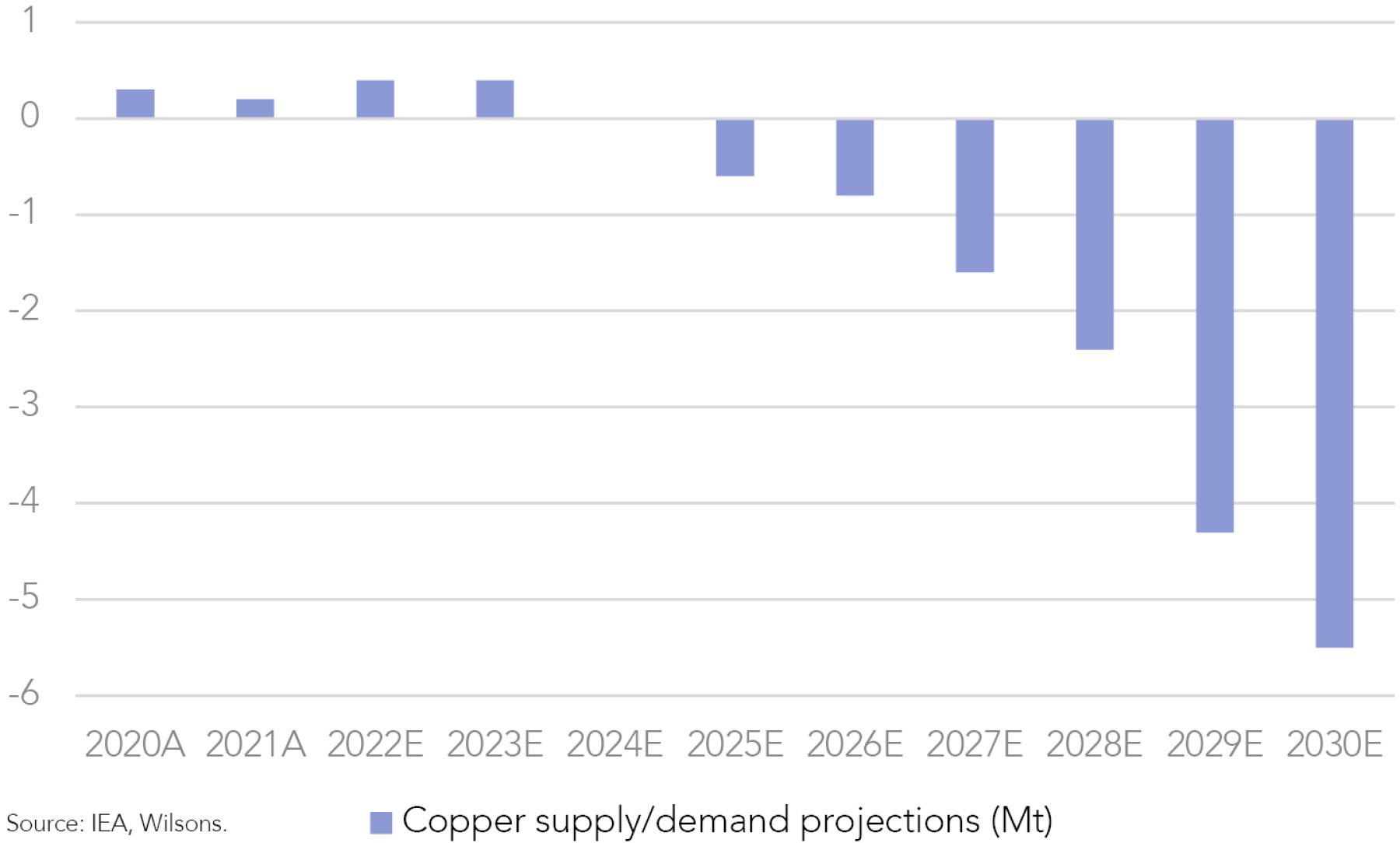
EVs typically require around 3x more copper than comparable conventional internal combustion engine vehicles. Solar and offshore wind require an estimated 2x and 5x, respectively, more copper per megawatt of installed capacity than popular fossil fuel energy sources. Therefore, we expect there to be an abundance of demand for copper over the long term. By 2035, copper demand is expected to nearly double to 50m metric tons. By 2050, the demand for coal will exceed 53m mt. Putting this figure in perspective, that's more copper than the world consumed over the last 120 years.
Increased copper demand is expected to outpace new supply given the shortfall of existing production volumes and committed projects in the pipeline.
There is a long lead-time involved between discovery and production, with lead times averaging 17 years according to the IEA.
OZ Minerals (OZL) our preferred copper exposure
The Focus Portfolio has exposure to copper through OZ Minerals (OZL) (2% position); and indirectly via BHP Group (BHP) (6% position), which generates ~20% of its EBITDA from the metal.
OZL remains our preferred copper exposure given:
- OZL is one of the purest large cap exposures to copper on the ASX, with ~70% of revenues being attributable to the metal.
- The miner has a quality portfolio of long-life, low-cost assets in stable jurisdictions. OZL’s Carrapateena mine in South Australia has a mine life of 23 years and is in the first quartile of the global cost curve.
- There is a clear pathway to more than doubling production volumes through both brownfield expansions and greenfield projects.
- OZL has been a prudent manager of capital over time, delivering an average return on invested capital of ~9% over the past 5 years.
M&A interest
OZL recently rejected an indicative takeover proposal from BHP at A$25 per share. We remain optimistic that further bids will emerge at a larger premium.
Oil & Gas in the Transition
Lowering emissions is a complex long-term global issue. The outlook for turning emissions around is likely to be a mix of energies, not one solution.
Renewable energies, increased efficiency, and a variety of innovative technologies are all needed.
Natural gas is also required. Gas burns more efficiently than coal or oil and emits significantly fewer greenhouse gases than other fossil fuels while being a reliable source of energy. Gas will play a key role in providing reliable ‘baseload’ power to supplement more intermittent solar and wind during the transition, at least until energy storage improves. Typically, global infrastructure is better prepared to transition to gas than renewables at present, making it more cost-effective for countries in the short-term. Thus, it can play a crucial role in supporting the transition to renewable energy.
According to the International Energy Agency (IEA), natural gas will have a greater share of the global energy mix in the future as oil and coal's relative share declines and renewables increase.
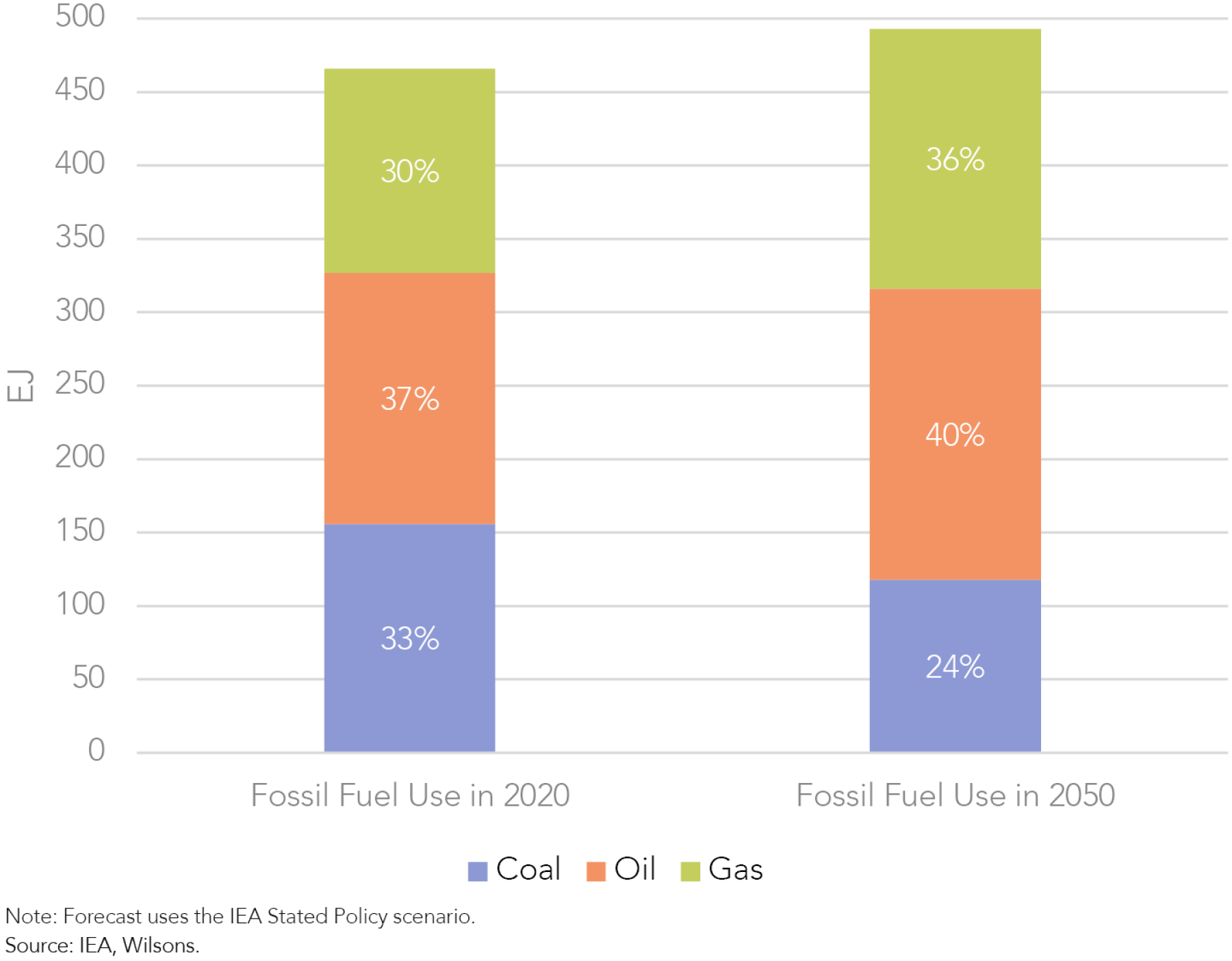
By the mid-2030s, the IEA predicts natural gas will replace coal as the world's second most important energy source. The gas supply will need to grow significantly to meet current commitments.
Oil and gas capex has fallen over the last 8 years, we think the current demand-supply dynamics are favourable for oil and gas prices over the medium-term, especially in an environment where demand can remain steady through the transition.
In the Focus Portfolio, our key exposures are to Santos (STO) 4% and Woodside Energy (WDS) 3%.
| Company Name (Ticker) | FY23 PE (Consensus) | FY24 PE (Consensus) | FY23 EPS Upgrades (Spot) | FY24 EPS Upgrades (Spot) | FY23 PE (Spot) | FY24 PE (Spot) |
| Woodside (WDS) | 6.9x | 8.4x | 27% | 71% | 5.4x | 4.9x |
| Santos (STO) | 7.2x | 9.1x | 22% | 56% | 5.9x | 5.8x |
Source: Refinitiv, Wilsons
Other Stocks to Play The Thematic
Pilbara Minerals (PLS)
- Pureplay lithium miner. Owns 100% of the Pilgangoora hard-rock lithium mine in Western Australia, as well as 18% of a downstream joint venture with POSCO with an option to increase to 30%.
- Spodumene production is expected to increase to ~1mt by FY28, up from 360kt in FY22.
- While PLS screens attractively on near-term valuation multiples, the company appears to offer less valuation appeal over the medium-term.
IGO (IGO)
- Diversified ‘clean energy metals’ miner, with exposure to nickel and lithium, as well as and copper and cobalt to a lesser extent.
- Has a joint venture with Tianqi Lithium Corporation (IGO 49% stake), which collectively owns 51% of the Greenbushes hard-rock lithium mine in Western Australia and 100% of the downstream Kwinana Lithium Hydroxide Refinery.
- Greenbushes is a large-scale, long-life, low-cost asset.
Mineral Resources (MIN)
- Diversified exposure to predominantly lithium and mining services, as well as (low quality) iron ore.
- MIN owns 2 low-cost hard rock lithium assets in Western Australia: Mt Marion and Wodgina.
- A speculated NYSE spin-off of the lithium business could untap hidden value in the business.
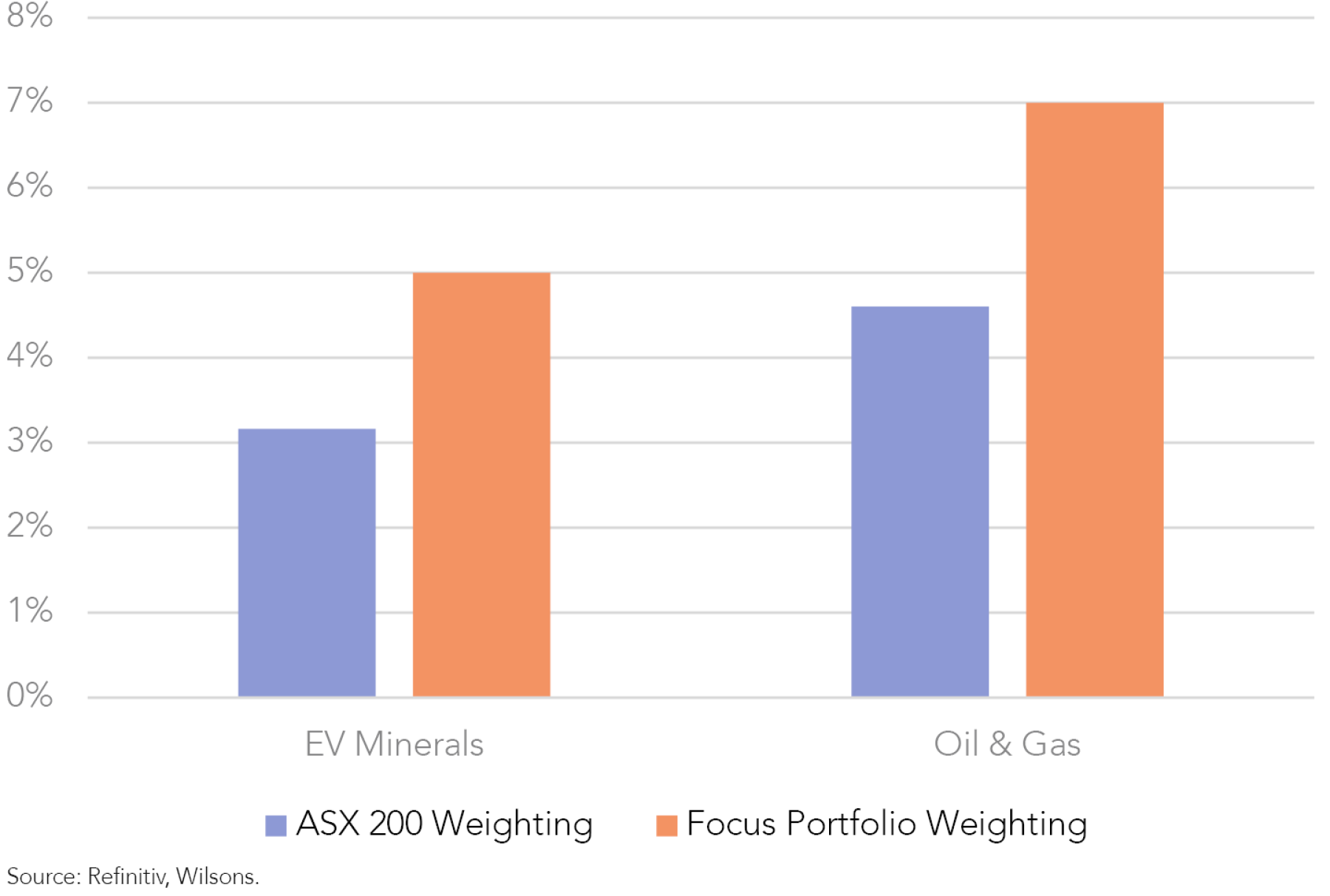

Written by
Rob Crookston, Equity Strategist
Rob is an experienced research analyst with a background in both equity strategy and macroeconomics. He has a strong knowledge of equity strategy, asset allocation, and financial and econometric modelling.
About Wilsons Advisory: Wilsons Advisory is a financial advisory firm focused on delivering strategic and investment advice for people with ambition – whether they be a private investor, corporate, fund manager or global institution. Its client-first, whole of firm approach allows Wilsons Advisory to partner with clients for the long-term and provide the wide range of financial and advisory services they may require throughout their financial future. Wilsons Advisory is staff-owned and has offices across Australia.
Disclaimer: This communication has been prepared by Wilsons Advisory and Stockbroking Limited (ACN 010 529 665; AFSL 238375) and/or Wilsons Corporate Finance Limited (ACN 057 547 323; AFSL 238383) (collectively “Wilsons Advisory”). It is being supplied to you solely for your information and no action should be taken on the basis of or in reliance on this communication. To the extent that any information prepared by Wilsons Advisory contains a financial product advice, it is general advice only and has been prepared by Wilsons Advisory without reference to your objectives, financial situation or needs. You should consider the appropriateness of the advice in light of your own objectives, financial situation and needs before following or relying on the advice. You should also obtain a copy of, and consider, any relevant disclosure document before making any decision to acquire or dispose of a financial product. Wilsons Advisory's Financial Services Guide is available at wilsonsadvisory.com.au/disclosures.
All investments carry risk. Different investment strategies can carry different levels of risk, depending on the assets that make up that strategy. The value of investments and the level of returns will vary. Future returns may differ from past returns and past performance is not a reliable guide to future performance. On that basis, any advice should not be relied on to make any investment decisions without first consulting with your financial adviser. If you do not currently have an adviser, please contact us and we would be happy to connect you with a Wilsons Advisory representative.
To the extent that any specific documents or products are referred to, please also ensure that you obtain the relevant disclosure documents such as Product Disclosure Statement(s), Prospectus(es) and Investment Program(s) before considering any related investments.
Wilsons Advisory and their associates may have received and may continue to receive fees from any company or companies referred to in this communication (the “Companies”) in relation to corporate advisory, underwriting or other professional investment services. Please see relevant Wilsons Advisory disclosures at www.wilsonsadvisory.com.au/disclosures.
